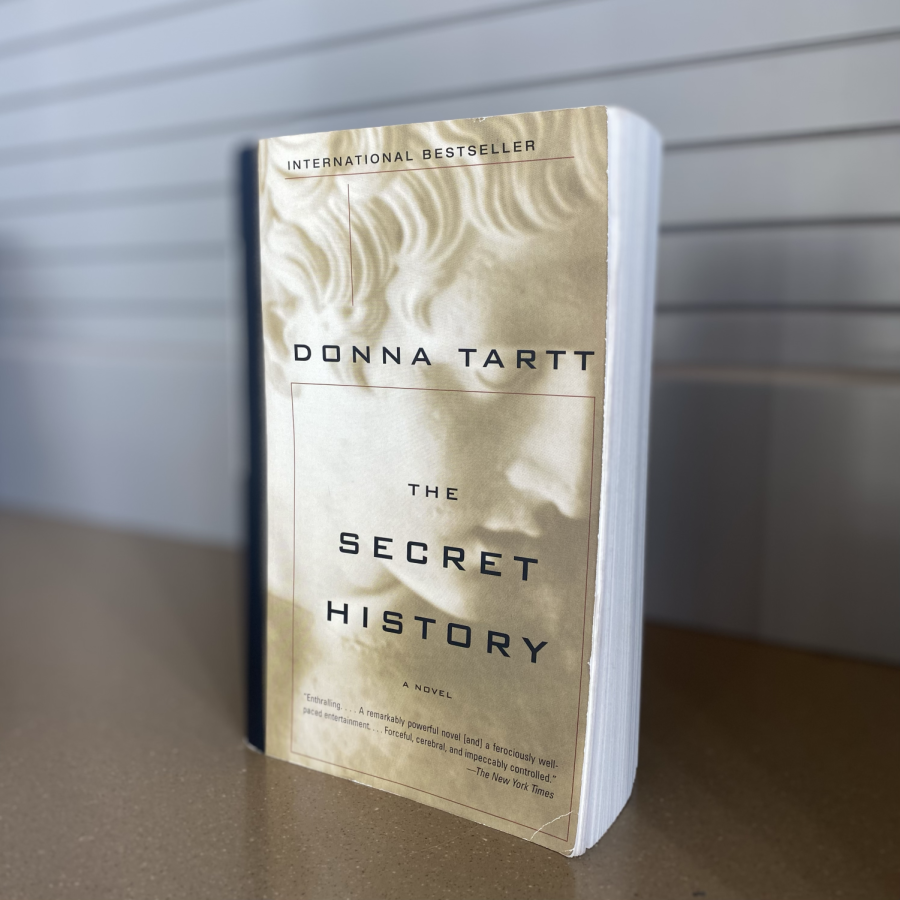Book Corner: ‘Beauty is harsh’
“The Secret History,” a 1992 novel by Donna Tartt, carries one theme throughout: Beauty is terror, and the incessant pursuit of beauty, whether through constructing a certain persona or chasing a sensory experience, leads to evil. The characters’ descent into madness and subsequently, ruin, illustrates the consequences of pursuing a glamorous, hedonistic existence and reminds us to appreciate the good, not the beautiful.
An onslaught of white as far as your eyes can see. Freezing, you trudge your way through heaps of snow. Yet the blindingly beautiful scene masks a treacherous murder, as you and other Vermonters discover 10 days later.
Donna Tartt’s “The Secret History” carries one theme throughout: Beauty is terror, and the incessant pursuit of beauty, whether through constructing a certain persona or chasing a sensory experience, leads to evil. As an artist, I personally have struggled with perfectionism and often obsess over the aesthetics of my work. Though far more extreme, the protagonists of Tartt’s novel and their descent into respective Jungian night-sea-journeys demonstrate the crippling and perilous effects of the pursuit of beauty.
The novel begins with California native Richard Papen entering the picturesque Hampden College in rural Vermont to study literature. Upon his arrival, he finds himself drawn to a mysterious group of students, a highly exclusive and sophisticated ancient Greek society. Richard’s idolization of his classmates soon revealed to me his intense desire to fit in, as well as his unreliability as a narrator. What begins as mild curiosity transforms into an ugly infatuation, and Richard remains in the clique even when they begin to scheme a murder, all for the sake of personal image.
As an avid historical fiction fan, it took a leap of faith to embark on the 592-page psychological thriller. Yet with each transpiring event, I became more entranced with the characters, as well as their actions and quirks, despite their more than questionable morality. And although their situation was far from relatable, I saw glimmers of myself in them, especially in how they wanted to be perceived.
For example, when the clique’s recognized leader Henry Winter is accused of murder, he contemplates which author’s novel he should carry around in order to leave a better impression instead of ingratiating himself with the police. When I first began creating sculptures and installations, I too often wondered what would appeal to aesthetics instead of focusing on what actually matters: the narrative of my piece.
Tartt masterfully chronicles this weakness of human nature — prioritizing beauty over all else — through each character’s idiosyncrasies, such as their tendencies to romanticize pain and spend excessively. She blends this central theme into the clever erudite banter and debauched Dionysian rituals that take place, instilling equal amounts of awe and horror in the reader.
I would recommend this book to those that struggle with an obsession with image, whether private or public. The characters’ descent into madness and subsequently, ruin, illustrates the consequences of pursuing a glamorous, hedonistic existence and reminds us to appreciate the good, not the beautiful.
“Does such a thing as ‘the fatal flaw,’ that showy dark crack running down the middle of a life, exist outside literature? I used to think it didn’t. Now I think it does. And I think that mine is this: a morbid longing for the picturesque at all costs.” — Donna Tartt, “The Secret History”

Alena Suleiman (12) is the co-editor-in-chief of Harker Aquila, and this is her fourth year on staff. Alena wishes to interact with new people and work...


















![“[Building nerf blasters] became this outlet of creativity for me that hasn't been matched by anything else. The process [of] making a build complete to your desire is such a painstakingly difficult process, but I've had to learn from [the skills needed from] soldering to proper painting. There's so many different options for everything, if you think about it, it exists. The best part is [that] if it doesn't exist, you can build it yourself," Ishaan Parate said.](https://harkeraquila.com/wp-content/uploads/2022/08/DSC_8149-900x604.jpg)




![“When I came into high school, I was ready to be a follower. But DECA was a game changer for me. It helped me overcome my fear of public speaking, and it's played such a major role in who I've become today. To be able to successfully lead a chapter of 150 students, an officer team and be one of the upperclassmen I once really admired is something I'm [really] proud of,” Anvitha Tummala ('21) said.](https://harkeraquila.com/wp-content/uploads/2021/07/Screen-Shot-2021-07-25-at-9.50.05-AM-900x594.png)







![“I think getting up in the morning and having a sense of purpose [is exciting]. I think without a certain amount of drive, life is kind of obsolete and mundane, and I think having that every single day is what makes each day unique and kind of makes life exciting,” Neymika Jain (12) said.](https://harkeraquila.com/wp-content/uploads/2017/06/Screen-Shot-2017-06-03-at-4.54.16-PM.png)








![“My slogan is ‘slow feet, don’t eat, and I’m hungry.’ You need to run fast to get where you are–you aren't going to get those championships if you aren't fast,” Angel Cervantes (12) said. “I want to do well in school on my tests and in track and win championships for my team. I live by that, [and] I can do that anywhere: in the classroom or on the field.”](https://harkeraquila.com/wp-content/uploads/2018/06/DSC5146-900x601.jpg)
![“[Volleyball has] taught me how to fall correctly, and another thing it taught is that you don’t have to be the best at something to be good at it. If you just hit the ball in a smart way, then it still scores points and you’re good at it. You could be a background player and still make a much bigger impact on the team than you would think,” Anya Gert (’20) said.](https://harkeraquila.com/wp-content/uploads/2020/06/AnnaGert_JinTuan_HoHPhotoEdited-600x900.jpeg)

![“I'm not nearly there yet, but [my confidence has] definitely been getting better since I was pretty shy and timid coming into Harker my freshman year. I know that there's a lot of people that are really confident in what they do, and I really admire them. Everyone's so driven and that has really pushed me to kind of try to find my own place in high school and be more confident,” Alyssa Huang (’20) said.](https://harkeraquila.com/wp-content/uploads/2020/06/AlyssaHuang_EmilyChen_HoHPhoto-900x749.jpeg)



